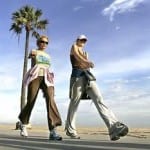Written by: Wallace Merriman

 Walking with a purpose
Walking with a purpose
I thought I should cover some pointers for those of you who are venturing outside. This is especially true with the shorter days of winter. I also want you to be able to deal with walking faster or walking with a purpose, as I like to call it. That can lead to side stitches and if you’ve had one, you know they hurt. I want you to move more, but I want you to be safe doing it.
Tie Your Shoes before walking
I always like to start with stating the obvious. John Wooden used to show his basketball players how to put on their socks. I know it seems too simple to even mention, yet stepping on laces is one of the easiest ways to land on your face whether you’re outdoors or on a treadmill. If you feel that lace flopping, stop and tie it or get off the treadmill and do it before you fall.
Wear Layers while walking
You’ve heard a million times that it’s best to wear layers in cold weather, but it’s especially true when you’re exercising. Too few layers and you return home a miserable chunk of shivers; too many and you’re chilled from frozen sweat. If you have a layer you can remove or at least unzip as you warm up, the whole experience will be more comfortable, and you’ll be less likely to call it off tomorrow. Wear sunglasses, especially when there’s glare from ice and snow. And don’t forget the hat and gloves; your extremities need protection from the cold, but it’s good to have pockets to stuff them in if you get too warm.
Watch for Drivers
This is a bigger problem than you realize if you don’t regularly go outside to exercise. It seems that most drivers are talking on cell phones when they drive, so their attention is divided. Add to that drivers never looking right when they are making a right-hand turn, and you have the potential for a problem–drivers are concerned only with what’s coming from the left. Never enter an intersection unless you’ve made eye contact with the driver. In fact, even that isn’t a guarantee. I was out for a run, made what I thought was eye contact with the driver, and the guy still pulled out when I was in front of his truck. If not for his passenger screaming at him, I’d have gotten hit. Better to wave them on and wait than take a chance.
Be Ready for Ice
Those of you in the south won’t have this problem very often, but for many of us–and I hate to say it–the snow isn’t far away. Don’t walk or run on ice unless you’ve got the proper apparel. This is especially true when there’s a little light snow covering the ice. A fall on the ice can screw up your workouts for days or even weeks. “Break a leg” is a great expression when you’re ready to on stage to perform but definitely not during exercise.
Deal with Side Stitches
This seems to happen as you increase the intensity of your workouts. Walking with a purpose to increase the intensity does the same thing. The cause of side stitches is still not well understood. Many believe that it’s a spasm of the diaphragm due to the increased rate of breathing. Others feel that it’s a spasm of the intercostals or serratus anterior muscles–both muscles involved in the rib cage. One theory even suggests that it’s caused by the ligament that attaches the liver to the diaphragm.
While opinions vary as to the cause, the cure is less elusive: experience. That’s right. The longer you exercise, the better-trained your entire body will become, and that includes the rib cage and all the connective tissue. While that’s little comfort when you’re bent over in pain, there are a couple of things you can do. First, warm up slowly. Get a rhythmic breathing pattern going as you warm up so that by the time you really start breathing heavily, your entire rib cage will be warmed up as well. If you still get a stitch, slow down and see if you can get a finger or knuckle on the point of pain. If you can feel the cramp, gently massage it until you feel it release. Side stitches will occur and will slow you down–just don’t let them stop you. They’ll come less often as you get more experience exercising.
Take Your Cell Phone
Finally, always carry a cell phone with you when you exercise outside. Always take it for your safety. If I fall, or if I see someone else who fell, I’m ready. If you’re going to make walking or any form of outdoor exercise a part of your life you have to deal with the outdoors. This is just one more way all the exercise you’re doing now will benefit you in the future: by making sure you’re still around.
By The Better Life Institute
